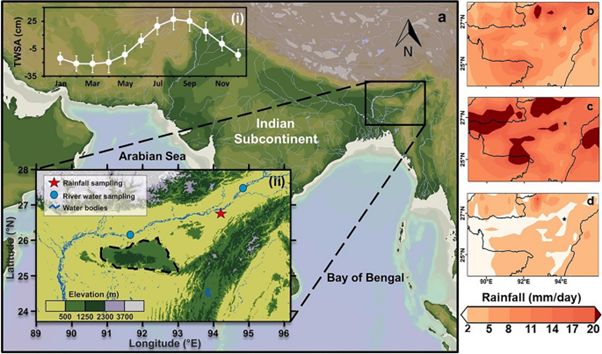
North-East India, home to the wettest place on the planet (Mawsynram), is a major biodiversity hotspot. This region experiences dynamic weather governed by complex orography, with the Himalayas to the north and the Shillong Plateau further south, coupled with presence of the largest (by volume) Indian river (Brahmaputra), as well as vast wetlands and forest cover, akin to the Amazon.
Thus, we expect a maximum (>> 40%) role of localized recycling in this region. The existing literature also identifies this region with maximum localized recycling in India. However, the maximum estimated contribution of recycled moisture from the existing studies is limited to ~ 25%.
The average annual rainfall of North-East India is ~ 2000 mm, and ~ 25% of it rains during the pre-monsoon (March–May) period. The pre-monsoon heavy rainfall is associated with Nor’westers (atmospheric instabilities caused when warm and moist southwest winds are overrun by the cold and dry westerlies).
During the Indian Summer Monsoon (June–September) season, North-East India receives ~ 1500 mm of rainfall. This hefty rainfall together with glacial melting during summers causes severe floods in Brahmaputra River, and observed through the GRACE (Gravity Recovery and Climate Experiment) TWSA (Terrestrial water storage anomaly) seasonal fluctuations, indicating increased water availability. These floods refill the water in low lying flood plains and widespread wetlands of the region.
Moisture recycling in precipitation is an important hydrological process, accounting for ~ 67% globally. North-east India, home to the world's wettest place, boasts vast wetlands and forest-cover. Despite its proximity to the coast, a study in the journal Nature by Ganguly et al ‘Extreme local recycling of moisture via wetlands and forests in North-East Indian subcontinent: a Mini-Amazon’ finds locally recycled moisture to be the primary annual source of rainfall (~ 45%).
The study aims to decipher the role of Shillong Plateau and Brahmaputra in influencing the regional hydro-meteorology, and to estimate seasonal contribution of continentally recycled moisture in regional precipitation using stable isotopes (δ18O, δ2H), satellite-observations, reanalysis data as well as HYSPLIT (Hybrid Single-Particle Lagrangian Integrated Trajectory) model simulations.
During the pre-monsoon season, the enriched δ18O (~ − 0.7 ‰) and high d-excess (~ 14 ‰) are ascribed to enhanced transpiration, owing to atmospheric instability which causes Nor’westers. During the Monsoon season, oceanic flux provides increased surficial moisture, enabling deep-localised convection via evaporation.
Significant localised recycling, even during the monsoon season is estimated (~ 38%), with predominantly high d-excess in precipitation during latter half of the monsoon with increased moisture contribution from floods in Brahmaputra (high d-excess).

The increasing δ18O and d-excess during the post-monsoon season is associated with progressively lesser rainout history and increased localized recycling (~ 67%). In light of the dwindling wetlands and forest-cover, our study highlights their indispensable role in governing regional hydro-meteorology and water availability.
Indian summer monsoon
North-east India receives maximum (~ 1500 mm) rainfall during the Indian Summer Monsoon season (Jun-Sep). Indian Summer Monsoon is set about with the northward migration of the Intertropical Convergence Zone, thus driving a huge influx of oceanic (Bay of Bengal and Arabian Sea) moisture inland. Unlike pre-monsoon, the regional hydro-meteorology to the north and south of the Shillong Plateau are analogous. The huge influx of oceanic moisture drives a sharp increasing trend of available surface water both to the north and south of the Plateau.
Post-monsoon
North-East India receives very scanty rainfall during the post-monsoon (Oct–Dec) due to the retreat of the Intertropical Convergence Zone, resulting in systematic decline of oceanic contribution along with weakening of monsoonal winds. The backward wind trajectory map also suggests that the distance traversed by the winds progressively reduces from Oct–Dec, thus drawing moisture from further inland. The estimated contribution of locally recycled moisture also shows an increasing trend from Oct (~ 58%)–Dec (~ 93%). We observe a progressively increasing trend in both δ18O and d-excess in precipitation with shortened rainout history.
Implications of high moisture recycling
The study has brought to light the vital role of locally recycled moisture to precipitation throughout the year (~ 45%), at least to the north of the Shillong Plateau. During the pre-monsoon season, we highlight the increased role of transpired moisture to precipitation, hence, signifying the importance of vegetation and forest cover. During the Indian Summer Monsoon season, influx of oceanic moisture and floods in Brahmaputra greatly increases the surficial water availability in low lying floodplains and wetlands, promoting enhanced recycling via evaporation.
Several studies have reported dwindling wetlands and forest cover due to overexploitation, urbanisation, siltation and deforestation. This puts an increased stress on ecosystems and biodiversity as well as loss of livelihood and economy. Owing to climate change, a notable shift in precipitation pattern has been reported.
On top of this, the study highlights the vital role of forest cover and wetlands in the regional hydrology and precipitation patterns. Further anthropogenic activities such as rapid urbanization, building of dams or barrages could greatly endanger the regional hydrology and water availability.
The full paper can be accessed here
/articles/local-recycling-moisture-wetlands-and-forests-high-north-east-india